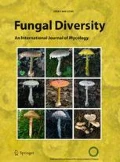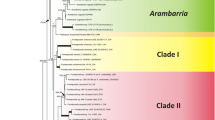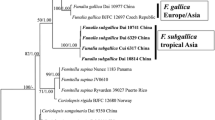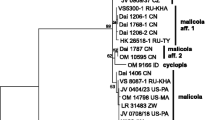Abstract
We present a taxonomic study of ‘group Favolus’ and related species in Polyporus. Phylogenetic analyses of nurLSU and ITS regions revealed that the infrageneric ‘group Favolus’ is divided into two main clades. Fungi within the group share laterally stipitate basidiocarps, with non-crustose stipe surfaces, and are distinguishable by the morphology of the pileus surface. One clade is characterized by species with hyaline to brown cutis, composed of hyaline to brown agglutinated generative hyphae. The other clade accommodates species with radially striate pileus, and lacks any distinct cutis of agglutinated hyphae. We propose Neofavolus gen. nov., typified by N. alveolaris, for the former clade, and revise the genus Favolus, typified by F. brasiliensis, for the latter clade. Neofavolus includes N. mikawai and N. cremeoalbidus sp. nov., known only from temperate eastern Asia, in addition to N. alveolaris. Favolus includes members of the Polyporus grammocephalus complex, the P. tenuiculus complex, and P. pseudobetulinus. We reveal that the polypore known as ‘P. grammocephalus’ in Asia includes F. acervatus and F. emerici (= P. grammocephalus), whereas ‘P. tenuiculus’ includes three distinct species; F. brasiliensis from tropical America, and F. spathulatus and F. roseus from tropical Asia. Detailed descriptions and illustrations are provided for the accepted species in Favolus and Neofavolus.












Similar content being viewed by others
References
Alfredo J, Hibbett DS (2011) Phylogenetic classification of Trametes (Basidiomycota, Polyporales) based on a five-marker dataset. Taxon 60(6):1567–1583
Bernicchia A (2005) Polyporaceae s.l. Edizioni Candusso, Alassio
Bondartsev AS (1953) The Polyporaceae of the European USSR and Caucasia (translated from Russian). Israel Program for Scientific Translation, Jerusalem, 1971
Boulet B (2003) Les champignons des arbres de l’ est de l’ Amérique du Nord. Les Publications du Québec, Québec
Corner EJH (1983) Ad Polyporaceas I: Amauroderma and Ganoderma. Beih Nova Hedwig 75:1–182
Corner EJH (1984) Ad Polyporaceas II & III. Beih Nova Hedwig 78:1–222
Cui BK, Yuan HS, Dai YC (2008) Wood-rotting fungi in eastern China 1. Polypores from Wuyi Mountains, Fujian Province. Sydowia 60:25–40
Cunningham GH (1965) Polyporaceae of New Zealand. N Z Dep Sci Ind Res Bull 164:1–304
Dai YC, Cui BK, Yuan HS, He SH, Wei YL, Qin WM, Zhou LW, Li HJ (2011) Wood-inhabiting fungi in southern China 4. Polypores from Hainan Province. Ann Bot Fenn 48:219–231
Dai YC (2012) Polypore diversity in China with an annotated checklist of Chinese polypores. Mycoscience 53:49–80
Domański S, Orłaś H, Skirgiełło A (1967) Fungi. Polyporaceae II (pileatae) Mucronoporaceae II (pileatae) Ganodermataceae, Bondarzewiaceae, Boletopsidaceae, Fistulinaceae (Grzyby), revised ed. Translated from Polish, Foreign Scientific Publications Department of the National Center for Scientific, Technical, and Economic Information, Warsaw, 1973
Donk MA (1933) Revision de Niederlandischen Homobasidiomycetes. Aphyllophoraceae II. Meded Bot Mus Herb Rijks Univ Utrecht 9:1–141
Drechsler-Santos ER, Ryvarden L, Wartchow F, Cavalcanti MAQ (2008) Polyporus elongoporus (Aphyllophorales, Poriaceae) sp. nov. Synopsis Fungorum 25:38–43
Farris JS, Källersjö M, Kluge AG, Bult C (1994) Testing significance of incongruence. Cladistics 10:315–319
Furtado JS (1981) Taxonomy of Amauroderma (Basidiomycetes, Polyporaceae). Mem N Y Bot Gard 34:1–109
Gibertoni TB, Ryvarden L, Cavalcanti MAQ (2004) Studies in Neotropical polypores 18. New species from Brazil. Synopsis Fungorum 18:44–56
Gilbertson RL, Ryvarden L (1987) North American Polypores, vol 2. Fungiflora, Oslo, pp 437–885
Guindon S, Dufayard JF, Lefort V, Anisimova M, Hordijk W, Gascuel O (2010) New algorithms and methods to estimate maximum-likelihood phylogenies: assessing the performance of PhyML 3.0. Syst Biol 59(3):307–321
Härkönen M, Niemelä T, Mwasumbi L (2003) Tanzanian mushrooms: edible, harmful and other fungi. Norrlinia 10:1–200
Hattori T, Zang M (1995) List of polypores collected in East China. Bull Natn Sci Mus Ser B 21:95–105
Holmgren PK, Holmgren NH, Barnet LC (1990) Index herbariorum. Part 1: the herbaria of the world, 8th edn. New York Botanical Garden, NY
Hosaka K, Castellano MA (2008) Molecular phylogenetics of Geastrales with special emphasis on the position of Sclerogaster. Bull Natn Sci Mus Ser B 34:161–173
Imazeki R (1939) Studies in Ganoderma of Nippon. Bull Tokyo Sci Mus 1:29–52
Imazeki R (1943) Genera of Polyporaceae of Nippon. Bull Tokyo Sci Mus 6:1–111
Katoh K, Toh H (2008) Recent developments in the MAFFT multiple sequence alignment program. Brief Bioinform 9:286–298
Krüger D, Gargas A (2004) The basidiomycete genus Polyporus—an emendation based on phylogeny and putative secondary structure of ribosomal RNA molecules. Feddes Repert 115:530–546
Lloyd CG (1915) Mycological Writings 4. Letter 54:1–8
Lloyd CG (1920) Mycological notes 64. Mycol Writ 6:985–1029
Nylander JAA (2004) MrModeltest 2.2. Program distributed by the author. Evolutionary Biology Centre, Uppsala University
Núñez M, Ryvarden L (1995a) Polyporus (Basidiomycotina) and related genera. Synopsis Fungorum 10:1–85
Núñez M, Ryvarden L (1995b) Polypores new to Japan 1. Species of Polyporus, with a note on P. hartmanni. Mycoscience 36:61–65
Núñez M, Ryvarden L (2001) East Asian Polypores Vol. 2. Synopsis Fungorum 14:1–522
Ryvarden L (1984) Type studies in the Polyporaceae 16. Species described by J.M. Berkeley, either alone or with other mycologists from 1856 to 1886. Mycotaxon 20:329–363
Ryvarden L (1985) Type studies in the Polyporaceae 17. Species described by W.A. Murrill. Mycotaxon 23:169–198
Ryvarden L (1989) Type studies in the Polyporaceae 21. Species described by C.G. Lloyd in Cyclomyces, Daedalea, Favolus, Fomes and Hexagonia. Mycotaxon 35:229–236
Ryvarden L (1990) Type studies in the Polyporaceae 22. Species described by C.G. Lloyd in Polyporus. Mycotaxon 38:83–102
Ryvarden L (1991) Genera of polypores, nomenclature and taxonomy. Synopsis Fungorum 5:1–363
Ryvarden L, Gilbertson RL (1994) European polypores part 2. Synopsis Fungorum 7:394–743
Ryvarden L, Iturriaga T (2003) Studies in neotropical polypores 10. New polypores from Venezuela. Mycologia 95:1066–1077
Ryvarden L, Iturriaga T (2004) Studies in Neotropical polypores 21. New and interesting species from Venezuela. Fungorum 18:68–75
Ryvarden L, Johansen I (1980) A preliminary polypore flora of east Africa. Synopsis Fungorum 5:1–636
Silveira RMB, Wright JE (2005) The taxonomy of Echinochaete and Polyporus s. str. in South America. Mycotaxon 93:1–59
Singer R (1986) The Agaricales in modern taxonomy, 4th edn. Koeltz Scientific Books, Germany
Sotome K, Hattori T, Kakishima M (2007) Polyporus phyllostachydis sp. nov. with notes on other rhizophilic species of Polyporus. Mycoscience 48:42–46
Sotome K, Hattori T, Ota Y (2009a) Second report of Polyporus longiporus and its phylogenetic position. Mycoscience 50:415–420
Sotome K, Hattori T, Ota Y (2011) Taxonomic study on a threatened polypore, Polyporus pseudobetulinus, and a morphologically similar species. P. subvarius. Mycoscience 52:319–326
Sotome K, Hattori T, Ota Y, Lee SS, Vikineswary S, Abdullah N, Kakishima M (2009b) Taxonomic study of Asian species of Echinochaete (Polyporaceae, Basidiomycota) and description of E. maximipora sp. nov. Mycol Prog 8:123–132
Sotome K, Hattori T, Ota Y, To-anun C, Salleh B, Kakishima M (2008) Phylogenetic relationships of Polyporus and morphologically allied genera. Mycologia 100:603–615
Swofford DL (2003) PAUP 4.0b10: phylogenetic analysis using parsimony. Sinauer Associates, Sunderland
Thorn G, Kotiranta H, Niemelä T (1990) Polyporus pseudobetulinus comb. nov.: New records in Europe and North America. Mycologia 82:582–594
Wang B, Cui BK, Li HJ, Du P, Jia BS (2011) Wood-rotting fungi in eastern China 5. Polypore diversity in Jiangxi Province. Ann Bot Fenn 48:237–246
Yasuda A (1915) Mycological notes 42. Bot Mag Tolyo 29:235–237
Acknowledgments
We are grateful to Ms. Y. Ando, Prof. Y.C. Dai (Beijing Forestry University), Dr. T. Fukiharu, Mr. E. Hatano, Ms. A. Hatano,, Dr. T. Kasuya, Mr. S. Kurogi, Prof. N. Maekawa (Tottori University), Mr. R. Nakano, Prof. E. Nagasawa, Mr. H. Sasaki, Mr. T. Suda, Prof. S. Tsujiyama (Kyoto Prefectural University) for kindly providing specimens. We would like to express our thanks to the curator of U.S. National Fungus Collections (BPI), National Museum of Nature and Science, Tokyo (TNS), Royal Botanic Gardens, Kew (K) and Muséum National d’Histoire Naturelle (PC) for the loan of holotypes and other specimens. We are also grateful to Dr. S. A. Redhead for his kind help on this study. This study was partly supported by Global COE Program “Advanced Utilization of Fungus/Mushroom Resources for Sustainable Society in Harmony with Nature”, MEXT, Japan.
Author information
Authors and Affiliations
Corresponding author
Rights and permissions
About this article
Cite this article
Sotome, K., Akagi, Y., Lee, S.S. et al. Taxonomic study of Favolus and Neofavolus gen. nov. segregated from Polyporus (Basidiomycota, Polyporales). Fungal Diversity 58, 245–266 (2013). https://doi.org/10.1007/s13225-012-0213-6
Received:
Accepted:
Published:
Issue Date:
DOI: https://doi.org/10.1007/s13225-012-0213-6




